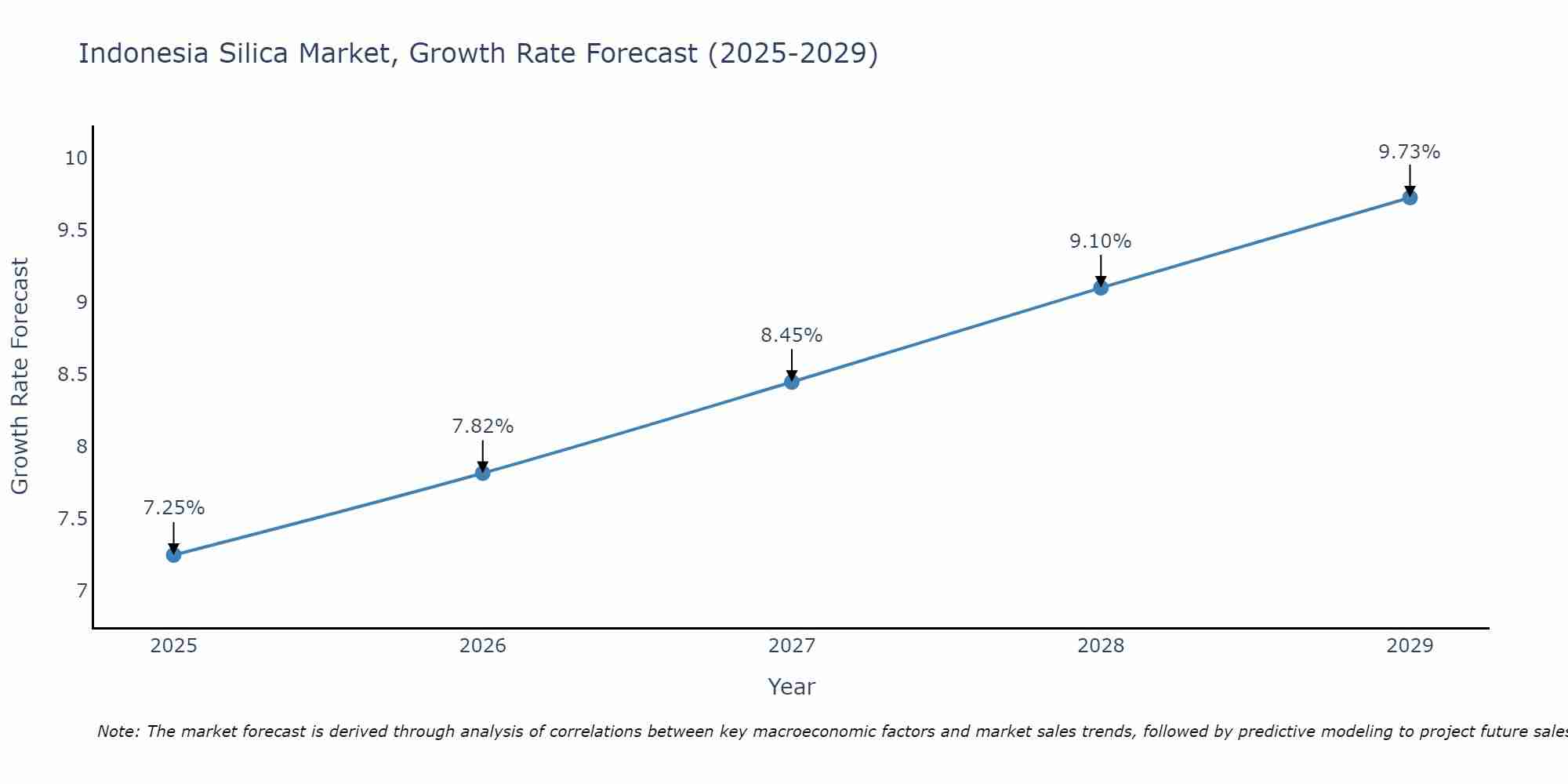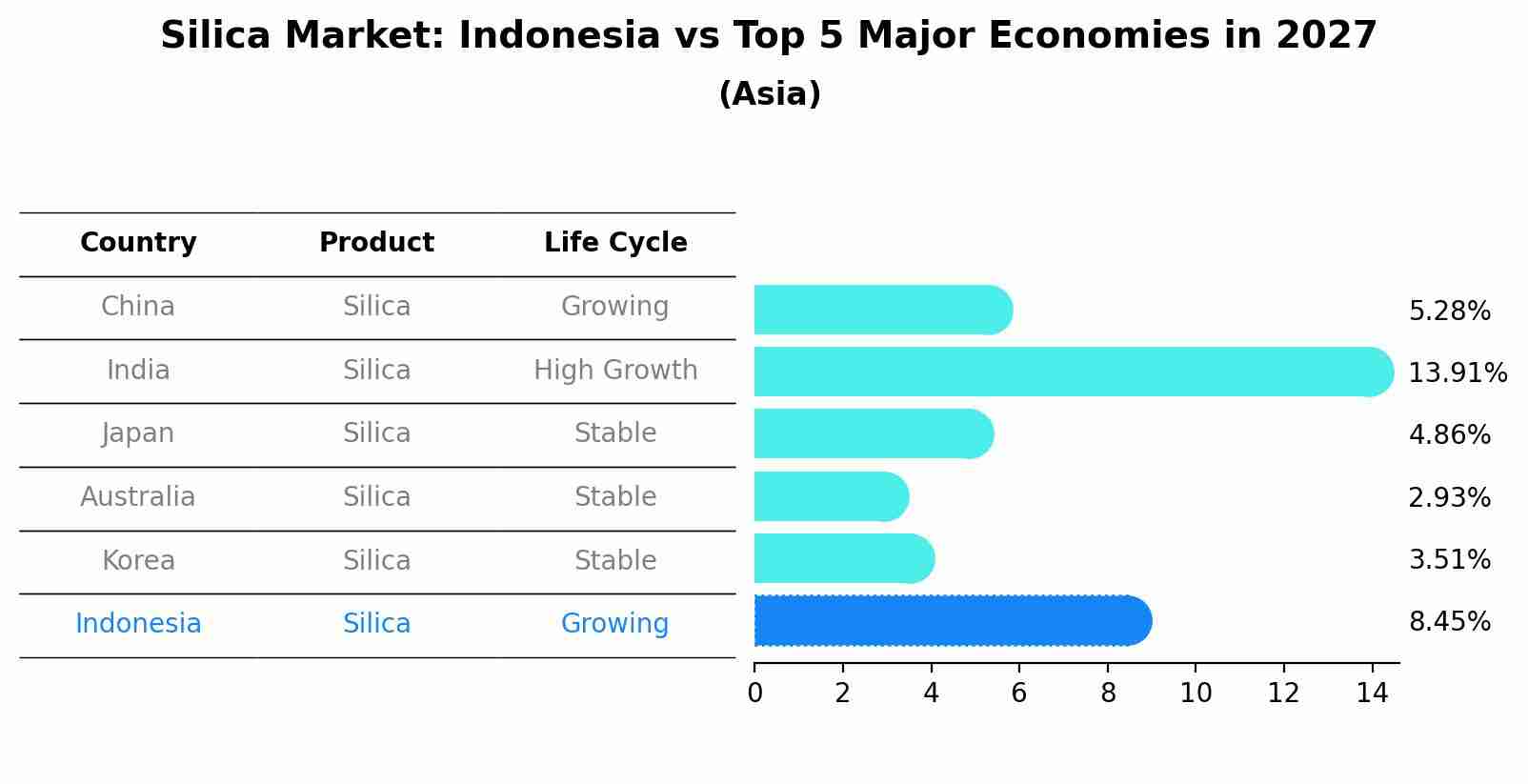Indonesia Silica Market (2025-2031) Outlook | Revenue, Companies, Share, Trends, Size, Industry, Analysis, Value, Growth & Forecast
| Product Code: ETC346468 | Publication Date: Aug 2022 | Updated Date: Aug 2025 | Product Type: Market Research Report | |
| Publisher: 6Wresearch | Author: Ravi Bhandari | No. of Pages: 75 | No. of Figures: 35 | No. of Tables: 20 |
Indonesia Silica Market Size Growth Rate
The Indonesia Silica Market is likely to experience consistent growth rate gains over the period 2025 to 2029. From 7.25% in 2025, the growth rate steadily ascends to 9.73% in 2029.

Silica Market: Indonesia vs Top 5 Major Economies in 2027 (Asia)
The Silica market in Indonesia is projected to grow at a growing growth rate of 8.45% by 2027, highlighting the country's increasing focus on advanced technologies within the Asia region, where China holds the dominant position, followed closely by India, Japan, Australia and South Korea, shaping overall regional demand.

Indonesia Silica Market Synopsis
The Indonesia silica market is witnessing steady growth due to its wide-ranging applications across various industries. Silica is a crucial component in manufacturing glass, ceramics, and construction materials. The market outlook for silica in Indonesia is positive, driven by increasing construction activities, infrastructure development, and the glass manufacturing sector.
Drivers of the Market
The Indonesia silica market is experiencing substantial growth, driven by its versatile applications across various industries. Silica is a key component in industries like glass manufacturing, construction, and electronics, all of which are witnessing robust expansion. In the glass industry, the demand for silica is rising due to the construction boom and increased use of glass in architecture and automotive sectors. Additionally, the construction industry relies on silica for its use in concrete production and as a filler in paints and coatings. The electronics industry benefits from the use of high-purity silica in semiconductor manufacturing, which is essential for modern electronic devices. Moreover, silica`s role in the cosmetics and personal care industry as a thickening and anti-caking agent is also contributing to its market growth. Furthermore, Indonesia`s rich natural resources of silica sand and ongoing mining operations make it a key player in the global silica market. Overall, the Indonesia silica market is thriving due to its diverse applications and the growing demand in key industries.
Challenges of the Market
The Indonesia silica market confronts challenges related to the extraction and processing of silica. Environmental concerns, including deforestation and habitat disruption, arise from mining activities. Sustainable sourcing and extraction practices are crucial to mitigate these issues. Additionally, competition from other materials in various industries, like alternative minerals and synthetic substitutes, poses a threat. To overcome these challenges, industry players must focus on eco-friendly practices, invest in research and development for innovative silica applications, and diversify their product portfolios to remain competitive.
COVID-19 Impact on the Market
The silica market faced challenges as industrial production slowed down during the pandemic. Reduced demand from various industries, including automotive and manufacturing, affected silica consumption. However, the market is expected to recover as industrial activities pick up pace with economic stabilization.
Key Players in the Market
The Indonesia silica market is driven by a few major players who play a pivotal role in supplying silica for various industrial applications. Companies like Sibelco, Toyota Tsusho Corporation, and PT. Surya Wiraldo are prominent in this market. Sibelco, a global leader, provides a wide range of silica products tailored to meet the diverse needs of industries such as glass manufacturing, construction, and automotive. Toyota Tsusho Corporation specializes in high-purity silica used in the semiconductor industry, catering to the growing electronics sector in Indonesia. PT. Surya Wiraldo, a local player, has gained recognition for its silica sand used in construction and infrastructure development projects across the country.
Key Highlights of the Report:
- Indonesia Silica Market Outlook
- Market Size of Indonesia Silica Market, 2024
- Forecast of Indonesia Silica Market, 2031
- Historical Data and Forecast of Indonesia Silica Revenues & Volume for the Period 2021-2031
- Indonesia Silica Market Trend Evolution
- Indonesia Silica Market Drivers and Challenges
- Indonesia Silica Price Trends
- Indonesia Silica Porter's Five Forces
- Indonesia Silica Industry Life Cycle
- Historical Data and Forecast of Indonesia Silica Market Revenues & Volume By Application for the Period 2021-2031
- Historical Data and Forecast of Indonesia Silica Market Revenues & Volume By Rubber for the Period 2021-2031
- Historical Data and Forecast of Indonesia Silica Market Revenues & Volume By Construction for the Period 2021-2031
- Historical Data and Forecast of Indonesia Silica Market Revenues & Volume By Agrochemicals for the Period 2021-2031
- Historical Data and Forecast of Indonesia Silica Market Revenues & Volume By Oral Care for the Period 2021-2031
- Historical Data and Forecast of Indonesia Silica Market Revenues & Volume By Food & Feed for the Period 2021-2031
- Historical Data and Forecast of Indonesia Silica Market Revenues & Volume By Others for the Period 2021-2031
- Indonesia Silica Import Export Trade Statistics
- Market Opportunity Assessment By Application
- Indonesia Silica Top Companies Market Share
- Indonesia Silica Competitive Benchmarking By Technical and Operational Parameters
- Indonesia Silica Company Profiles
- Indonesia Silica Key Strategic Recommendations
Frequently Asked Questions About the Market Study (FAQs):
1 Executive Summary |
2 Introduction |
2.1 Key Highlights of the Report |
2.2 Report Description |
2.3 Market Scope & Segmentation |
2.4 Research Methodology |
2.5 Assumptions |
3 Indonesia Silica Market Overview |
3.1 Indonesia Country Macro Economic Indicators |
3.2 Indonesia Silica Market Revenues & Volume, 2021 & 2031F |
3.3 Indonesia Silica Market - Industry Life Cycle |
3.4 Indonesia Silica Market - Porter's Five Forces |
3.5 Indonesia Silica Market Revenues & Volume Share, By Application, 2021 & 2031F |
4 Indonesia Silica Market Dynamics |
4.1 Impact Analysis |
4.2 Market Drivers |
4.2.1 Growing demand from industries such as construction, automotive, and electronics due to the properties of silica. |
4.2.2 Increasing investments in infrastructure development projects in Indonesia. |
4.2.3 Rising awareness about the benefits of using silica in various applications. |
4.3 Market Restraints |
4.3.1 Fluctuating prices of raw materials impacting the production costs of silica. |
4.3.2 Stringent environmental regulations related to silica mining and processing. |
4.3.3 Competition from substitute materials impacting the demand for silica in certain industries. |
5 Indonesia Silica Market Trends |
6 Indonesia Silica Market, By Types |
6.1 Indonesia Silica Market, By Application |
6.1.1 Overview and Analysis |
6.1.2 Indonesia Silica Market Revenues & Volume, By Application, 2021-2031F |
6.1.3 Indonesia Silica Market Revenues & Volume, By Rubber, 2021-2031F |
6.1.4 Indonesia Silica Market Revenues & Volume, By Construction, 2021-2031F |
6.1.5 Indonesia Silica Market Revenues & Volume, By Agrochemicals, 2021-2031F |
6.1.6 Indonesia Silica Market Revenues & Volume, By Oral Care, 2021-2031F |
6.1.7 Indonesia Silica Market Revenues & Volume, By Food & Feed, 2021-2031F |
6.1.8 Indonesia Silica Market Revenues & Volume, By Others, 2021-2031F |
7 Indonesia Silica Market Import-Export Trade Statistics |
7.1 Indonesia Silica Market Export to Major Countries |
7.2 Indonesia Silica Market Imports from Major Countries |
8 Indonesia Silica Market Key Performance Indicators |
8.1 Average selling price of silica products. |
8.2 Number of infrastructure projects utilizing silica-based products. |
8.3 Percentage of silica production meeting environmental compliance standards. |
8.4 Innovation rate in silica product development. |
8.5 Adoption rate of silica in new industries or applications. |
9 Indonesia Silica Market - Opportunity Assessment |
9.1 Indonesia Silica Market Opportunity Assessment, By Application, 2021 & 2031F |
10 Indonesia Silica Market - Competitive Landscape |
10.1 Indonesia Silica Market Revenue Share, By Companies, 2024 |
10.2 Indonesia Silica Market Competitive Benchmarking, By Operating and Technical Parameters |
11 Company Profiles |
12 Recommendations |
13 Disclaimer |
- Single User License$ 1,995
- Department License$ 2,400
- Site License$ 3,120
- Global License$ 3,795
Search
Thought Leadership and Analyst Meet
Our Clients
Related Reports
- Vietnam System Integrator Market (2025-2031) | Size, Companies, Analysis, Industry, Value, Forecast, Growth, Trends, Revenue & Share
- ASEAN and Thailand Brain Health Supplements Market (2025-2031) | Strategy, Consumer Insights, Analysis, Investment Trends, Opportunities, Growth, Size, Share, Industry, Revenue, Segments, Value, Segmentation, Supply, Forecast, Restraints, Outlook, Competition, Drivers, Trends, Demand, Pricing Analysis, Competitive, Strategic Insights, Companies, Challenges
- ASEAN Bearings Market (2025-2031) | Strategy, Consumer Insights, Analysis, Investment Trends, Opportunities, Growth, Size, Share, Industry, Revenue, Segments, Value, Segmentation, Supply, Forecast, Restraints, Outlook, Competition, Drivers, Trends, Demand, Pricing Analysis, Competitive, Strategic Insights, Companies, Challenges
- Europe Flooring Market (2025-2031) | Outlook, Share, Industry, Trends, Forecast, Companies, Revenue, Size, Analysis, Growth & Value
- Saudi Arabia Manlift Market (2025-2031) | Outlook, Size, Growth, Trends, Companies, Industry, Revenue, Value, Share, Forecast & Analysis
- Uganda Excavator, Crane, and Wheel Loaders Market (2025-2031) | Strategy, Consumer Insights, Analysis, Investment Trends, Opportunities, Growth, Size, Share, Industry, Revenue, Segments, Value, Segmentation, Supply, Forecast, Restraints, Outlook, Competition, Drivers, Trends, Demand, Pricing Analysis, Competitive, Strategic Insights, Companies, Challenges
- Rwanda Excavator, Crane, and Wheel Loaders Market (2025-2031) | Strategy, Consumer Insights, Analysis, Investment Trends, Opportunities, Growth, Size, Share, Industry, Revenue, Segments, Value, Segmentation, Supply, Forecast, Restraints, Outlook, Competition, Drivers, Trends, Demand, Pricing Analysis, Competitive, Strategic Insights, Companies, Challenges
- Kenya Excavator, Crane, and Wheel Loaders Market (2025-2031) | Strategy, Consumer Insights, Analysis, Investment Trends, Opportunities, Growth, Size, Share, Industry, Revenue, Segments, Value, Segmentation, Supply, Forecast, Restraints, Outlook, Competition, Drivers, Trends, Demand, Pricing Analysis, Competitive, Strategic Insights, Companies, Challenges
- Angola Excavator, Crane, and Wheel Loaders Market (2025-2031) | Strategy, Consumer Insights, Analysis, Investment Trends, Opportunities, Growth, Size, Share, Industry, Revenue, Segments, Value, Segmentation, Supply, Forecast, Restraints, Outlook, Competition, Drivers, Trends, Demand, Pricing Analysis, Competitive, Strategic Insights, Companies, Challenges
- Israel Intelligent Transport System Market (2025-2031) | Strategy, Consumer Insights, Analysis, Investment Trends, Opportunities, Growth, Size, Share, Industry, Revenue, Segments, Value, Segmentation, Supply, Forecast, Restraints, Outlook, Competition, Drivers, Trends, Demand, Pricing Analysis, Competitive, Strategic Insights, Companies, Challenges
Industry Events and Analyst Meet
Whitepaper
- Middle East & Africa Commercial Security Market Click here to view more.
- Middle East & Africa Fire Safety Systems & Equipment Market Click here to view more.
- GCC Drone Market Click here to view more.
- Middle East Lighting Fixture Market Click here to view more.
- GCC Physical & Perimeter Security Market Click here to view more.
6WResearch In News
- Doha a strategic location for EV manufacturing hub: IPA Qatar
- Demand for luxury TVs surging in the GCC, says Samsung
- Empowering Growth: The Thriving Journey of Bangladesh’s Cable Industry
- Demand for luxury TVs surging in the GCC, says Samsung
- Video call with a traditional healer? Once unthinkable, it’s now common in South Africa
- Intelligent Buildings To Smooth GCC’s Path To Net Zero


















